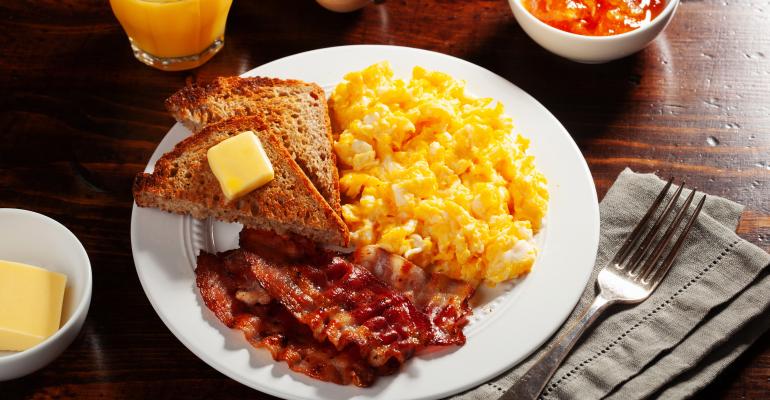Breakfast doesn’t get more homey or appealing than a plate of scrambled eggs with familiar accompaniments like bacon, home fries, and toast. But given the versatility of eggs and the ease of scrambling, that classic American combo is just the start of a long, varied flavor exploration for restaurant operators and foodservice managers.
Menu examples reflect numerous cultures, dietary regimens, appetites, and degrees of adventurousness. Take the Quinoa Scramble Bowl at Eleven City Diner in Chicago, with scrambled eggs, tomatoes, sautéed spinach, and quinoa. Or the Everything Breakfast at family dining chain Bob Evans, which pleases hearty eaters with three scrambled eggs, a trio of breakfast meats, tomatoes, cheddar cheese, hollandaise, and hash browns.
The Farmer’s Market Scramble at True Food Kitchen, a chain focused on chef-driven, seasonal food, combines pasture-raised eggs, sweet potato, charred onion, roasted Brussels sprouts, and two cheeses. Tre Rivali in Milwaukee menus Hoppel Poppel, a German-inspired medley of scrambled eggs, sausage, peppers, onions, potatoes, parmesan cheese, and pretzel croutons. Eggholic, a fast-casual Indian eatery in Chicago, serves up Egg Bhurji, a zesty scramble of vegetables and chilies topped with fresh cilantro.
However, the emergence of novel dishes such as those does not overshadow traditional scrambled egg dishes. “Consumers will always want foods that reflect the familiar flavors they know and love, but they continue to expand their palates with unique global fare,” says the 2023 What’s Hot Culinary Forecast by the National Restaurant Association.
Tapping into fresh, global flavors
Satisfying the yen for fresh, global flavors and authenticity is Andros Taverna, a contemporary Greek restaurant in Chicago by chef Doug Psaltis. He draws inspiration from the cosmopolitan tavernas of Greece and treasured family recipes to create a brunch menu “with a great mix of healthfulness, liveliness, and just enough indulgence,” Psaltis says.
Strapatsada, a dish Psaltis remembers his grandmother making, is “a great, simple scramble” of farm eggs served atop a flavorful mélange of tomatoes and feta sprinkled with oregano. Another popular item, the Fluffy Egg Pita, combines fluffy scrambled eggs, sliced gyros meat, and spicy whipped feta, folded into a pita and baked “until it’s nice and crunchy, with warm, cheesy eggs inside,” says Psaltis. The dish, dubbed Ikaria, after the Greek island famed for the extraordinary longevity of its inhabitants, is a scramble of egg whites, slow-cooked zucchini, tomatoes, and dill. “It’s very satisfying and comforting, yet also very healthy,” says Psaltis.
Authentic brunch fare finds a fertile market among college and university students eager for new culinary experiences. This fall, Chartwells Higher Education, a Charlotte, North Carolina-based contract foodservice company, debuted United Table, a new dining experience based on global flavors, at Northeastern University in Boston and University of Illinois Chicago, with plans for further expansion in the future.
United Table pleases international students seeking a taste of home as well as students in general who are curious about new foods. “When we survey our students, international flavors always rank very highly.” says Sarah Bodner, research and development chef at Chartwells. “This is a really cool way for us to create a space where the campus community can come together and share an experience through food.”
Breakfast offerings include Egg Bhurji Masala scrambled eggs; Huevos Pericos, which are Colombian scrambled eggs with tomatoes and scallions; and the Turkish scrambled egg dish Menemen. Students can customize their meals with zesty condiments such as sriracha, chili crisp, and black vinegar from a global sauce and spice bar.
“It's interesting to see how popular the global breakfast dishes are, along with our traditional American breakfasts like scrambled eggs and bacon,” says Bodner. “Students can expand their horizons because scrambled eggs are very familiar although the other ingredients may be new.”
Menuing culinary traditions
At Istanbul Hawaii in Honolulu, Chef Ahu Hettema brings a taste of Turkish culinary traditions to the Aloha State in her weekend brunch menu. Actually, Istanbul Hawaii opened with a Mediterranean fusion menu rather than a Turkish cuisine focus because Hettema thought the former would be more approachable for the local market. “But I found out that people here really want and enjoy Turkish food,” says Hettema. “They feel they are transported to Turkey by eating here.”
Weekend brunch celebrates Turkish breakfast staples such as tangy yogurt, house-made sourdough bread, Sucuk, which is a spiced beef sausage, semolina pancakes and the classic egg dish Menemen.
Menemen is prepared by first simmering eggs, tomatoes, onions, and green peppers together. The eggs are loosely scrambled into the flavorful sauce so they retain some integrity rather than becoming homogenized. “We serve it with crusty sourdough breads or pide, Turkish flatbread,” says Hettema.
Naturally, it is impossible to say when eggs were first cracked, stirred, and heated into an appetizing mass. But it must be one of humanity’s oldest and simplest cooking methods. From there, it was a short step to mix in any number of handy foods to boost flavor and nutrition, as many cultures have done.
“I think in the past people were just finding ways to stretch eggs further to feed the family,” says David Wakefield, executive chef of Farm Bar in Chicago, where Texas-style chilaquiles, scrambled eggs with sautéed tortillas, pickled red onions, queso fresco, and serrano tomatillo salsa, is a fan favorite at brunch.
Wakefield notes that although scrambled eggs may look simple, customers are very opinionated about it. “There are hundreds of ways to cook eggs, but to each of our guests, there's only one right way—the way they want them,” says Wakefield.
“Some people want their scrambled eggs a soft scramble,” says Wakefield. “Some people like them scrambled hard. Some people like them scrambled dry with no butter or no oil or anything. And then you have the classic French way of cooking scrambled eggs, by adding butter and stirring constantly to turn them into little curds.”
Adds Wakefield, “Here, we toe the line between soft scrambled and hard scrambled, and hope that resonates with guests. I think we’re usually on the mark.”





